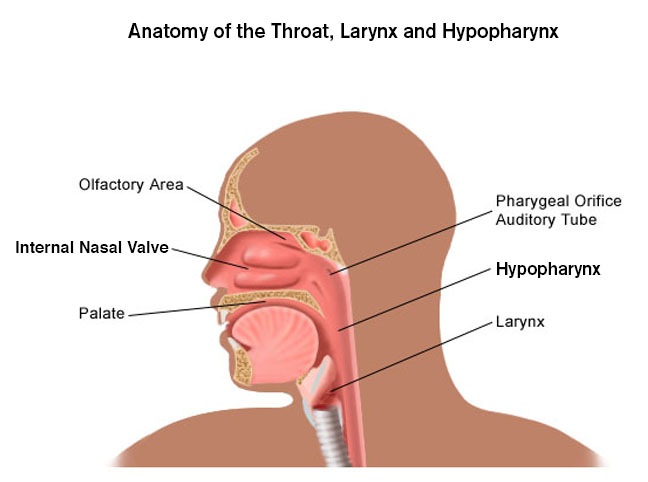Otolaryngology:
Head and Neck Cancers
Laryngeal cancer is a disease in which malignant (cancer) cells form in the tissue of the larynx. According to the American Cancer Society (ACS), approximately 12,000 people are diagnosed with laryngeal cancer in the United States every year and approximately 3,600 deaths will occur.
Hypopharyngeal cancer is very rare. Only about 2,500 cases are seen in the United States each year. Because of this, hypopharyngeal cancer is difficult to diagnose in its earliest stages and has one of the highest mortality rates of any head and neck cancer.
Laryngeal cancer includes cancerous cells found in any part of the larynx, which consists of the glottis, the supraglottis, subglottis and the epiglottis.
Hypopharyngeal cancer is a disease in which malignant cells grow in the hypopharynx (the area where the larynx and esophagus meet).
It first forms in the outer layer (epithelium) of the hypopharynx (last part of the pharynx), which is split into three areas. Progression of the disease is defined by the spread of cancer into one or more areas and into deeper tissues.
Otolaryngology surgeons at Brigham and Women’s Division of Otolaryngology at Brigham and Women's Faulkner Hospital specialize in surgical techniques for laryngeal and hypopharyngeal cancer. We offer the most current diagnostic methods and proven treatments, including minimally invasive surgical approaches aided by video technology. We are the surgical team for Dana-Farber/Brigham and Women's Cancer Center (DF/BWCC), an exceptional collaboration between two world-class medical centers.
The following are the most common symptoms of laryngeal cancer. However, each individual may experience symptoms differently. Symptoms may include:
The symptoms of laryngeal or hypopharyngeal cancer may resemble other conditions or medical problems. Always consult your health care provider for a diagnosis.
Read more about laryngeal cancer.

The exact cause of laryngeal cancer is not known. However, there are certain risk factors that may increase a person's chance of developing this cancer.
In addition to a complete medical history and physical examination, your health care provider may carefully examine your neck to check for lumps, swelling, tenderness, and other changes.
Other diagnostic exams may be performed:
Specific treatment for laryngeal and hypopharyngeal cancers will be determined by your doctor based on:
Treatment may include one, or a combination of, the following:
Careful monitoring and the involvement of an experienced otolaryngologist are important to the successful outcome for patients with ear, nose and throat disorders and conditions.
If you are having surgery or a procedure, you will likely be scheduled for a visit to the Weiner Center for Preoperative Evaluation for pre-operative information and tests.
If surgery is needed, you will be cared for in the operating room by an experienced otolaryngology surgeon. After surgery, you will recover in the post-surgical care unit where you will receive comprehensive care by an experienced medical and nursing staff.
Brigham and Women’s Faulkner Hospital provides a multidisciplinary approach to patient care by collaborating with colleagues who have extensive experience in diagnosing and treating ear, nose and throat disorders and conditions. In addition, patients have full access to Brigham and Women's Hospital's world-renowned academic medical community and state-of-the-art facilities.
When surgery is necessary, our board-certified surgeons offer extensive surgical experience, performing thousands of operations per year. Our otolaryngologists are faculty members at Harvard Medical School and active researchers who continually seek causes and investigate treatments for conditions and diseases affecting the ear, nose and throat.
Offering comprehensive medical, surgical and psychiatric care as well as complete emergency, ambulatory and diagnostic services to residents of southwest Boston and the surrounding suburbs.
Learn more about BWFH